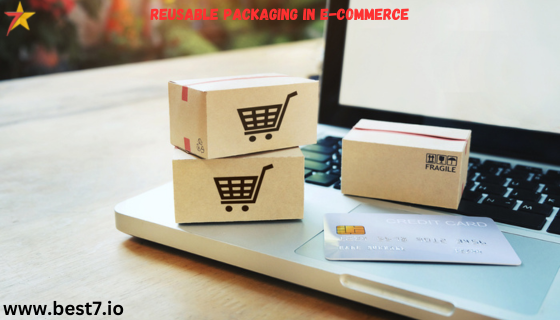
The advent of sustainable practices in the e-commerce sphere is becoming increasingly relevant today, with reusable packaging at the forefront of the movement. As consumer awareness around environmental issues grows, the demand for eco-friendly e-commerce solutions is expected to surge.
Moreover, future anticipations indicate that reusable packaging might not only help in the reduction of packaging waste but will also be an intrinsic part of the broader circular economy in packaging. This post discusses the current trends and potential challenges and looks into the future of reusable packaging with the help of relevant case studies.
Current Trends in the Development of Reusable Packaging
The implementation of reusable packing systems has been encouraged due to the interest of businesses in achieving their sustainability goals, with around 25% of e-commerce companies using reusable packaging by 2023. This trend is expected to grow by 2030, as it is anticipated that 50% of online stores will adopt this solution. The core trends that are most likely to affect the increase of interest in the target issue include:
- Customer Willingness to Pay for Sustainable Options
The growing sustainability consciousness among customers and the willingness to pay more for products packed in an environmentally friendly way: by 2040, 70% of people will be willing to pay the extra price for sustainably packed products, which may result in the further development of reusable packing systems. - Regulatory Push for Waste Reduction
The increase in governmental regulations regarding waste in packaging: as seen in the case of Walmart, which managed to reduce the use of packaging by 1.4 million tons in 2021, many e-commerce companies became more interested in sustainable packaging practices. It might be concluded that, by 2025, 60% of companies will be located in countries where waste will be strictly regulated by the government. - Advances in Functional and Sustainable Packaging
The advances in packaging practices and the development of more functional and sustainable reusable container systems, expected to reach 40% by 2030.
Advantages of Implementing Reusable Packaging
Reusable packaging brings a host of benefits for both companies and the environment. Key advantages include:
- Cost Savings for Businesses
Reusable packaging is generally designed to be more durable and long-lasting than single-use alternatives, allowing companies to reduce costs related to packaging acquisition and disposal. - Environmental Benefits of Reusability
Since reusable packaging is used multiple times, it lowers the environmental impact by reducing the waste generated from single-use packaging. - Corporate Contribution to Environmental Sustainability
Implementing reusable packaging allows businesses to minimize the environmental footprint of their operations, a crucial step in the context of climate change. - Collaborative Growth Opportunities
To ensure effective reusable packaging systems, businesses, logistics providers, and waste management companies must collaborate to develop efficient logistic processes supporting reusability. - Rising Consumer Awareness and Demand
It’s projected that by 2028, 50% of e-commerce brands will run campaigns to educate consumers on the benefits of reusability. - Shift Towards a Circular Economy
By 2035, as 70% of e-commerce companies implement circular approaches in their packaging systems, there will be a significant shift toward sustainability in the industry.
Challenges of Implementing Reusable Packaging
Despite its benefits, reusable packaging faces several challenges that must be addressed:
- Logistics and Distribution
Efficiently managing the return, refilling, and redistribution of reusable packaging requires coordinated logistics, which can be challenging. - Consumer Acceptance
Some consumers may resist reusable packaging due to perceptions of inconvenience or hygiene concerns. As of 2025, it is estimated that 30% of customers may resist reusable packaging unless educated or incentivized. - Risk and Investment Assessment
The shift to reusable packaging requires significant investment in new materials, processes, and business models, posing an initial risk for companies. - Standardization and Compatibility Issues
By 2028, the industry expects that over 40% of companies will collaborate to establish universal standards for reusable packaging. - Infrastructure Limitations
Companies’ abilities to invest in logistics infrastructure will impact the transition to reusable packaging, with 50% of logistics providers expected to establish necessary infrastructure by 2030.
The Future of Reusable Packaging in E-Commerce
Looking ahead, the future of reusable packaging in e-commerce promises innovative developments driven by sustainability goals. Key trends expected in this area include:
- Growing Adoption Rates
By 2030, projections indicate that 60% of e-commerce brands will adopt reusable packaging solutions, significantly reducing overall waste. - Expanding Circular Economy Practices
With a focus on reuse and recycling, 70% of e-commerce brands are expected to adopt circular economy solutions by 2035. - Consumer-Driven Demand for Sustainability
By 2028, 80% of consumers are projected to choose brands using reusable packaging solutions, signaling a strong consumer-driven push for sustainability. - Emerging Innovative Business Models
A growing number of businesses will adopt subscription-based models for reusable packaging solutions, with 25% of e-commerce brands expected to use these models by 2030. - Focus on Education and Awareness
Customer education will drive demand for reusable packaging, with half of e-retailers expected to launch sustainability awareness campaigns by 2025. - Data-Driven Optimization in Packaging Design
The role of data in decision-making will expand, with projections indicating that by 2035, 50% of e-commerce companies will use data analytics to optimize their packaging design and material choices.












